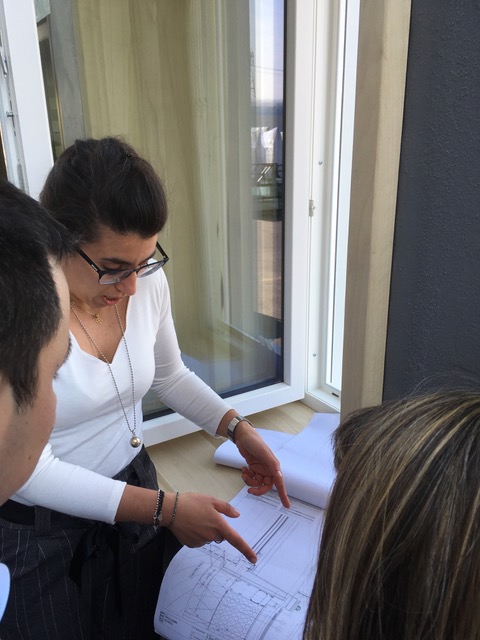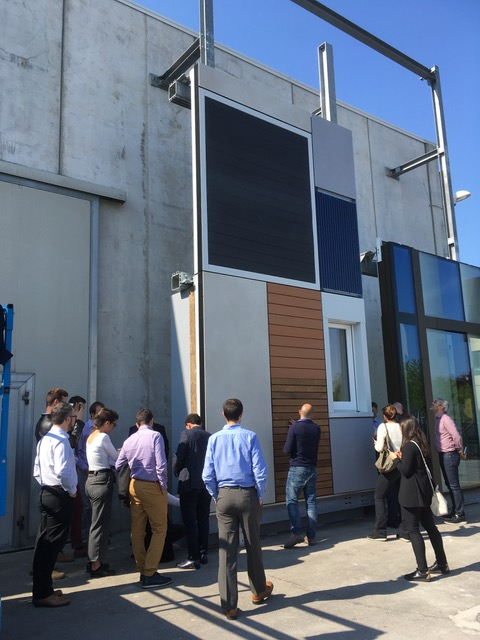![]() By Alex Rathmell*
By Alex Rathmell*
IPMVP is proving essential to evaluating a new generation of nearly-zero-energy building renovations in Europe.
Big ambition, big challenges
Governments across Europe have been directed to develop long-term decarbonisation strategies for buildings, via Article 2a of the Energy Performance of Buildings Directive. In practice this means that by 2050, most of Europe’s existing building stock will be upgraded to ‘nearly zero energy’ buildings (nZEBs). The question being asked currently is how this unprecedented transformation can be cost-effectively delivered.
Many aspects of the planned transition would be impossible without measurement and verification techniques, from commissioning, through to financing of nZEB solutions, through to user acceptance. But Europe is a relative latecomer to M&V – at least compared to North America – with widely variable adoption of the CMVP qualification across member states. So it is interesting to examine how IPMVP is being used in the current generation of innovation and demonstrator projects, and how this might evolve as solutions are rolled out commercially.
The European Commission’s gigantic ‘Horizon 2020’ science and innovation funding pot has mobilised a number of projects to develop technical and market-based solutions. These are typically delivered by consortia of private and academic organisations from across at least three member states. Some projects are focusing on technological aspects, such as new integrated systems of façades and roofs that deliver radical efficiency and on-site renewables. Other projects focus on mobilising finance and developing new business models.
RenoZEB
One project that is aiming to tackle a whole range of interrelated technical and market barriers is RenoZEB, running from 2017-21. The project is ambitious, aiming to unlock the nZEB renovation market by harnessing the anticipated uplift in property value renovated buildings will experience. This will be achieved through a new systemic approach to retrofitting, including innovative integrated façade components, processes and decision-making methodologies embedded in new software tools, and a BIM-based collaborative online environment to bring together all value-chain actors in the renovation process.
The project, a consortium of 19 organisations from across the EU, is developing cost-effective 'plug and play' façade solutions that will be deployed in a set of real and virtual demonstrators.
The real demonstrators are in two distinct climatic zones: Durango in northern Spain, where a 1960s apartment building owned by the municipality will be retrofitted, and Vöru in Estonia, where a largely owner-occupied apartment building dating from the 1980s will undergo renovation. Before either of these ‘real’ buildings are refurbished, the technologies and processes will be tested at the KUBIK test facility in Bilbao, Spain. In order to prove replicability in other countries and markets, the whole approach will also be validated using three virtual buildings.
Life-long monitoring
The project’s funder, the European Commission, is looking for replicable, scalable and sustainable solutions. In general, the shift to prefabricated construction and integrated panel and façade systems shifts some of the complexities of nZEB design away from the construction frontline, and economies of scale can be realised in the process.
Ye t, renovation contractors need to know how to specify and install these new solutions, which represent a radical departure from current techniques. One size does not fit all - really this is about mass customisation rather than mass production - and poor implementation will seriously compromise the performance of the finished building, so this must be monitored carefully.
t, renovation contractors need to know how to specify and install these new solutions, which represent a radical departure from current techniques. One size does not fit all - really this is about mass customisation rather than mass production - and poor implementation will seriously compromise the performance of the finished building, so this must be monitored carefully.
RenoZEB partners are developing collaboration platforms and resource libraries that can be easily adopted by contractors, and training resources covering deployment of off-site-built retrofit modules, maintenance and end-of-life planning.
Nevertheless, scaling all this to a continent-wide scale requires massive collection of data on real performance. Gone are the days when the retrofit industry can rely on deemed savings or calculated values. The new generation of nZEB buildings uses active technologies, live in-situ monitoring and continuous optimisation.
Work has been going on at a local level in Spain and Estonia for over 18 months to engage residents, building their acceptance and enthusiasm. The RenoZEB approach is user-centric, so the renovation balances the user’s individual comfort preferences with the need to reduce the overall energy use by over 60%. The resident will benefit from hugely improved control of their environment, harnessing natural daylight, better ventilation and air quality and precise temperature control. In practice this means the retrofitted facades are laden with IOT (internet of things) sensors, and a new communications gateway is installed as part of the refurbishment. Some residents will even be monitored using wearable devices, with smart software tracking their metabolic data to check their comfort level.
Thus, once the retrofits are installed, a cascade of performance data will follow. The consortium will use this to retro-commission the technologies, evaluate the conditions for residents, and estimate the uplift in property value. All this will inform the write-up of the project, underpinning future commercial variants of RenoZEB technologies.
However, M&V-minded readers will have noticed that the energy savings, central to the business case and a fundamental KPI for the project, cannot be ‘measured’ with monitoring equipment that is installed alongside the renovation solution. Without a baseline, any performance gap between the BIM-modeled savings and the savings experience in reality cannot be quantified. Fortunately the RenoZEB team has incorporated IPMVP into its evaluation design, and energy monitoring has already been installed in the demo buildings ahead of planned refurbishments to take place in 2020.

Baselining
Neither demonstration building was equipped with ‘smart’ or ‘advanced’ utility metering, and each uses multiple energy vectors. The energy conservation measures will target thermal insulation (windows, walls and roof surfaces), domestic hot water and improved controls, and are expected to deliver an energy saving of over 60%.
The retrofit solution affects the entire building and the ECMs will be installed together. As such, a large step-change in consumption is anticipated, but it is not intended that the contribution of each ECM will be disaggregated.
Despite this whole-building approach, the project’s emphasis on personalisation of the residents’ individual experience means that measurement at dwelling level is also essential. It is expected that residents will have distinct responses to the improvements in comfort and control resulting from the project, and understanding their behaviour and interaction with the solution is a key objective of the project. Active control technologies will respond to residents’ comfort levels, in some cases boosting savings by turning off ventilation while maintaining an acceptable comfort band, a process known as ‘demand flexibility’.
The concept of monitoring at dwelling level is in line with Measurement and verification Protocol for Net Zero Energy Buildings, IEA SHC-EBC 2013, which was a key source for developing the project’s M&V Plan. However, collecting multiple data streams from every apartment over several years poses challenges for data processing, and the frequency of readings has a bearing on sensor battery life. The table below shows all the parameters that were measured.

Two approaches to establishing a reference baseline were considered: an analytical approach – using a mathematical, parametrical model – and a detailed modeling approach based on calibrating the project’s existing BIM models. And within each of these alternatives, either the pre-installation or post-installation period could be used as the baseline.
An analytical method with a pre-installation baseline period was selected as the preferred approach, adherent with IPMVP Option C. This approach ensures the savings calculation is independent from the BIM-based solution modeling, providing a valuable additional datapoint on performance.
Analysis
The baseline calculation uses energy data from a whole-building level, with adjustments informed by data from external, building-level and apartment-level sensors. These data are combined to form ‘virtual sensors’ with the aim of explaining variations in building energy use that are not attributable to the project. One such virtual sensor involves an additional analytical process to decompose the energy use into heating, hot water and electrical device end-uses.
In anticipation of residents’ behaviour changing in response to their renovated environment, the project adopted a probabilistic model of whether heating would have been used, as a function of outdoor temperature conditions. This calculation is carried out at an apartment level.
The building-level baseline model will be created using piecewise multiple linear regression. Combinations of conditions monitored by virtual sensors, combined with outdoor air temperature and other key factors, will be tested to identify the best model. In fact, two distinct regression models will be used: one for the heating season and one for the rest of year, as energy use is radically different under these two regimes. An additional model calculates whether the heating is in use or not.
Future applications
The resulting analytical model is complex, but reflects the nuances of the project, and is designed to verify technologies that are pre-commercial (TRL 6-7). A substantial slice of the project’s €6.8m budget is devoted to monitoring and M&V activities.
In the ‘real’ (non-grant-funded) nZEBs of the future, this budget is unrealistic. For example it will not be justifiable to deploy the large number of sensors used in the RenoZEB demonstrators. Nevertheless, some level of performance M&V will need to be incorporated in commercial projects to ensure the benefits for residents and building owners are realised, particularly for commercial models that rely on repayments from residents. RenoZEB makes a material contribution to establishing good practice in this area.

(*) Alex Rathmell CEng MBA CMVP is a consultant based in the UK and Managing Director for Consultancy at EnergyPro, a fast-growing team of experienced energy professionals working to accelerate capital flows into energy efficiency. In 2011 Alex co-founded EEVS Insight, the UK’s largest and longest-established M&V centre of expertise, and remains an Associate at EEVS.
More information on RenoZEB can be found here: https://renozeb.eu
The RenoZEB project has received funding from the European Union’s Horizon 2020 research and innovation programme under grant agreement No. 768718. The sole responsibility for the content of this website lies with the authors. It does not necessarily reflect the opinion of the European Community.






